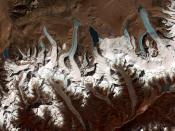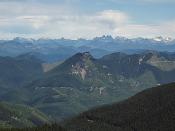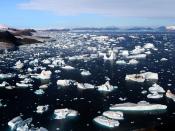GLACIERS!
In many of the world's high mountains, the heat of the summer is not enough to melt all the snow that falls in winter. Whenever this occurs year after year, there is a gradual accumulation of snow in the upper ends of mountain valleys. These areas where the snow lasts from year to year are known as snowfields. In the sunny days of summer the surface of a snowfield melts, and the water, sinking into the snow, freezes beneath the surface and helps change the snow to ice. The weight of the snow above also compacts the snow below. The melting and refreezing of the water and by pressure change the larger part of the snow of a snowfield changed into ice. These layers of snow and ice become glaciers when they begin to flow. The great thickness of a glacier causes it to move. The many layers of ice slide past each other and act as if they were on a slant.
As they melt they may create small lakes and ponds if the water has nowhere to go.
A glacier is a layered body of ice, consisting mainly of recrystallized snow that moves. They creep down hills and flow through valleys. Or crawls slowly to the sea over cold nearly flat lands.
Types
There are four kinds of glaciers. The most numerous and perhaps the most familiar are cirque glaciers. They frequently occupy duep steep-walled recesses or hollows that are situated high on the side of a mountain. The very small glaciers that occupy cirques are also commonly referred to as glacierets, niche glaciers, or corrie glaciers. In the coterminous United States there are about 950 cirque glaciers. There are about 1,500 in the European Alps. The largest glaciers are called ice caps. Huge ice caps...



Regarding negative rating
Everyone! If you rate my essay negative please leave a comment stating why. All the essays I submit I view are at least average and have been accepted by my school. I just want to know why you think my essays are bad so I can improve. If you do not leave a comment stating your reasoning I will email you for an answer.
3 out of 4 people found this comment useful.